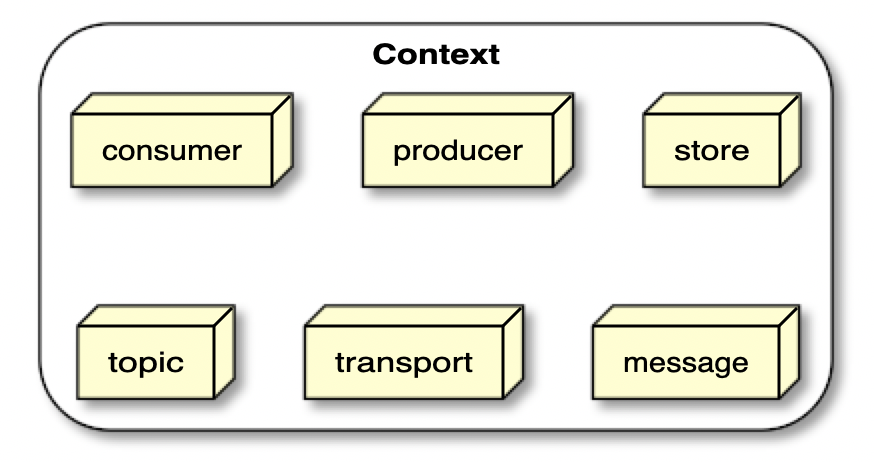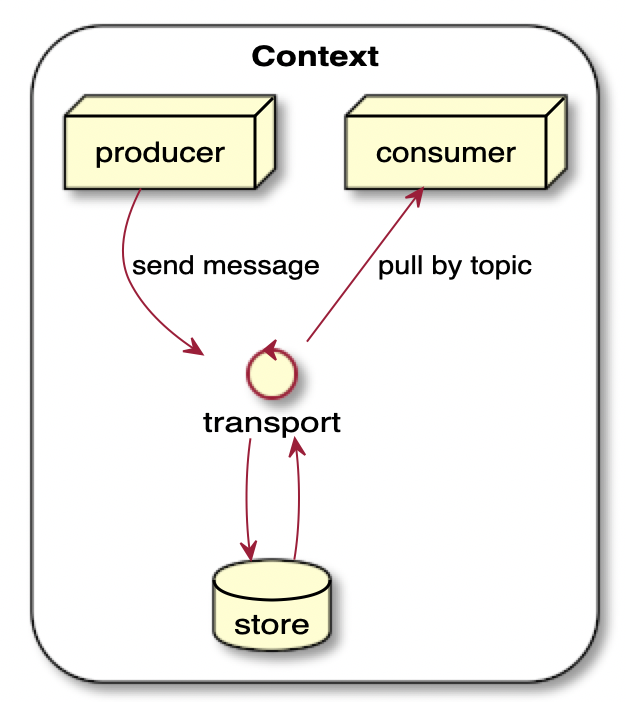Spring 嵌入式轻量消息队列
为Spring-boot提供消息队列能力的starter, 并提供了VM线程的轻量级实现。 项目地址: github.com/wangyuheng/…
什么是消息队列
消息队列是用于存放消息的容器,可供消费者取出消息进行消费。
观察者模式
观察者(Observer)模式的定义:指多个对象间存在一对多的依赖关系,当一个对象的状态发生改变时,所有依赖于它的对象都得到通知并被自动更新。这种模式有时又称作发布-订阅模式、模型-视图模式,它是对象行为型模式。

Observer 本来的意思是 观察者 ,但具体的实现中并不是主动去观察,而是被动的接收来自 Subject 的通知,所以更合适的名字应该是"消息投递"。 而且通知的模式还存在一个 弊端 : 通知及多个 ConcreteObserver 的消费程序仍在一个同步线程内,所以只是代码结构层面的解耦,底层还是一个事务内。 为了解决这个 弊端 ,将消息的发送及N个消费程序拆分为N+1个事务,所以引入消息队列用于存储 Subject 。

领域模型设计
- 罗列领域概念

- 梳理交互关系

代码实现
-
LinkedBlockingQueue作为存储Message的容器。 - Store用于存储消息。为了兼容多个
Consumer,每个Consumer指定一个唯一标识作为Partition Key,对应唯一的一个LinkedBlockingQueue。 e.g.Map<Partition, LinkedBlockingQueue<Message>> messageQueueMap = new ConcurrentHashMap<>(); -
Producer通过Transport将消息发送只多个Partition Key的LinkedBlockingQueue队列中 - 每个
Consumer开启一个线程,通过轮询方式从LinkedBlockingQueue队列中消费消息。
代码片段
- VmStore
private Map<Partition, LinkedBlockingQueue<Message>> messageQueueMap = new ConcurrentHashMap<>();
@Override
public void append(Message message, Partition partition) {
initQueue(partition);
messageQueueMap.get(partition).add(message);
}
@Override
public LinkedBlockingQueue<Message> findByPartition(Partition partition) {
initQueue(partition);
return messageQueueMap.get(partition);
}
private void initQueue(Partition partition) {
if (!messageQueueMap.containsKey(partition)) {
synchronized (this) {
if (!messageQueueMap.containsKey(partition)) {
messageQueueMap.put(partition, new LinkedBlockingQueue<>());
}
}
}
}
复制代码
- Transport
public void transfer(Message message) {
final String topic = message.getTopic();
topicClientIdMap.get(topic).forEach(clientId -> {
Partition partition = new Partition(clientId, topic);
store.append(message, partition);
});
}
复制代码
- ConsumerCluster
/**
* 开启消费线程
* 只能开启一次
*/
public synchronized void start(Store store) {
if (!initialized.get()) {
synchronized (this) {
SimpleAsyncTaskExecutor taskExecutor = new SimpleAsyncTaskExecutor();
taskExecutor.setDaemon(true);
taskExecutor.execute(new ConsumerListener(this.getMessageHandler(), store.findByPartition(this.generatePartition())));
initialized.set(true);
}
}
}
/**
* 关闭消费线程
*/
public void shutdown() {
liveToggle.set(false);
}
/**
* 暂停消费
*/
public void pause() {
runToggle.set(false);
}
/**
* 重启暂停的消费线程
*/
public void restart() {
runToggle.set(true);
}
class ConsumerListener implements Runnable {
private MessageHandler handler;
private LinkedBlockingQueue<Message> queue;
ConsumerListener(MessageHandler handler, LinkedBlockingQueue<Message> queue) {
this.handler = handler;
this.queue = queue;
}
@Override
public void run() {
while (true) {
try {
if (!liveToggle.get()) {
break;
}
if (runToggle.get()) {
Message message = queue.poll();
if (null == message) {
Thread.sleep(100);
} else {
handler.handle(message);
}
} else {
Thread.sleep(100);
}
} catch (InterruptedException e) {
Thread.currentThread().interrupt();
}
}
}
}
复制代码
使用 LinkedBlockingQueue 却未使用 take 方法的原因是为了灵活控制消费线程的启停。
spring集成
为了方便使用,通过 annotation 的形式与spring框架进行集成。
示例
- Consumer
@Consumer(topic = CONSUMER_TOPIC, id = CUSTOM_CONSUMER_ID)
public void consumerMessage(Message message) {
consumerRecordMap.get(CUSTOM_CONSUMER_ID).add(message);
}
复制代码
- Producer
@Autowired
private DefaultProducer<String> producer;
public void sendMessage(){
producer.send(new Message<>(CUSTOM_TOPIC, "This is a message!"));
}
复制代码
代码实现
/**
* 注册消费者bean
*
* @see Consumer
* @see MessageHandler
* @see Store
*/
public class ConsumerBeanDefinitionRegistryPostProcessor implements BeanPostProcessor, ApplicationContextAware {
private ConfigurableApplicationContext applicationContext;
@Override
public void setApplicationContext(ApplicationContext applicationContext) throws BeansException {
this.applicationContext = (ConfigurableApplicationContext) applicationContext;
}
@Override
public Object postProcessAfterInitialization(Object bean, String beanName) throws BeansException {
Class<?> targetClass = AopProxyUtils.ultimateTargetClass(bean);
Method[] methods = ReflectionUtils.getAllDeclaredMethods(targetClass);
for (Method method : methods) {
if (AnnotatedElementUtils.hasAnnotation(method, Consumer.class)) {
final String topic = method.getAnnotation(Consumer.class).topic();
final String id = StringUtils.isEmpty(method.getAnnotation(Consumer.class).id()) ? beanName + method.getName() : method.getAnnotation(Consumer.class).id();
final BeanFactory beanFactory = applicationContext.getBeanFactory();
final Store store = beanFactory.getBean(Store.class);
final MessageHandler messageHandler = message -> ReflectionUtils.invokeMethod(method, bean, message);
final BeanDefinitionBuilder beanDefinitionBuilder = BeanDefinitionBuilder.genericBeanDefinition(ConsumerCluster.class, () -> {
ConsumerCluster consumerCluster = new ConsumerCluster();
consumerCluster.setId(id);
consumerCluster.setTopic(topic);
consumerCluster.setMessageHandler(messageHandler);
consumerCluster.start(store);
return consumerCluster;
});
BeanDefinition beanDefinition = beanDefinitionBuilder.getRawBeanDefinition();
((DefaultListableBeanFactory) beanFactory).registerBeanDefinition(beanName + method.getName() + "Listener", beanDefinition);
}
}
return bean;
}
}
复制代码
正文到此结束
- 本文标签: IDE synchronized 一对多 http find AOP App 同步 db Transport UI ConcurrentHashMap REST ask tar IO CTO consumer tab queue map HashMap list src https executor 代码 final spring producer cat 模型 key client git bean GitHub Proxy spring集成 message 线程 id 消息队列 build BeanDefinition
- 版权声明: 本文为互联网转载文章,出处已在文章中说明(部分除外)。如果侵权,请联系本站长删除,谢谢。
- 本文海报: 生成海报一 生成海报二
热门推荐
相关文章
Loading...











![[HBLOG]公众号](https://www.liuhaihua.cn/img/qrcode_gzh.jpg)

